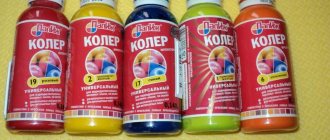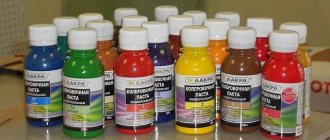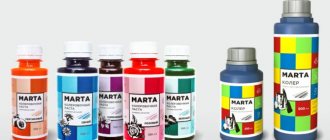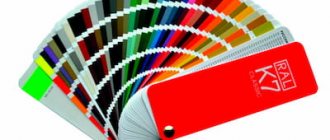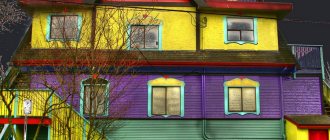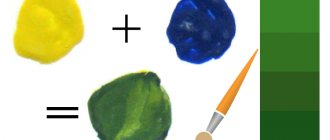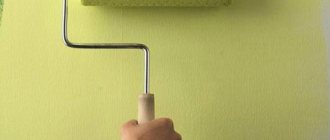Application of paint colors
Kohler is a highly concentrated coloring agent used to obtain absolutely any shade of paint of all types. Kohler is a lifesaver if the desired ready-made shade of paint is not available. You just need to correctly calculate the proportions, and the paint of any desired shade is ready.
Only with the help of color, having only one base, you can create harmonious transitions of one shade or take risks and combine contrasting bright colors. The intensity and saturation of color depends only on a person’s imagination.
Indeed, the color scheme is capable of realizing any, even the most daring, fantasies in the interior! Tinted paints are used on the following surfaces:
- plastered walls;
- brickwork;
- concrete surfaces;
- plasterboard surfaces;
- any wooden surfaces;
- plywood;
- wallpaper for painting.
The colors are also used for outdoor use due to their resistance to external factors.
Benefits of DIY tinting
Room after painting
- You can get custom shades;
- carrying out tinting at the site of repair work;
- saving money, especially when painting a small area.
Disadvantages include:
- difficulty re-creating tone;
- selection of the correct base for making dark tones;
- it is difficult to obtain the desired dark shade;
- not suitable for painting large volumes.
Do-it-yourself paint tinting is a unique opportunity to make your home unique and emphasize its individuality, original style and connection to the overall interior of the room. Only by making an unusual shade that a computer system will not create can you hide some surface imperfections and balance the color scheme in the room, which is a definite advantage.
The advantage of tinting over ready-made paint
By mixing the color with paint, you can optionally obtain the entire palette of shades, from delicate to bright and catchy. Perhaps this is its main advantage. After all, the choice of ready-made tint paints in stores is not so great.
The undoubted advantages of tinting also include the following:
- application for different types of surfaces from concrete to wood;
- the ability to correct defects in the first layer of paint: by changing the color intensity, you can lighten or darken the unsuccessful layer;
- the ability to obtain many harmonious shades of the same color: not a single ready-made paint can cope with this task and will not convey the entire palette and variety of shades;
- indispensable if you choose the wrong shade of paint or if it is not available in stores;
- ease of mixing manually or using a computer program: in fact, even a child can do it;
- ease of obtaining the desired shade.
What is paint tinting
Kohler is a special coloring composition. And tinting is mixing two colors to obtain the desired shade. Typically, in order to create paint of the desired shade, the dye must be mixed with white paint.
Unlike manual tinting, automatic tinting is a software selection of shades according to specified parameters, after which the system produces the exact proportions of all components that allow you to achieve the desired result.
Types of colors by composition and release form
On store shelves there is a huge selection of organic and synthetic colors of different types and consistencies, from universal to highly specialized colors. Some colors are universal, while others are intended only for certain jobs. Some colors will make the surface matte, others will make it shiny, and others will be covered with mother-of-pearl.
Pigments for paints
Pigments are finely ground powders of artificial and natural origin of different shades. They are obtained from the oxide and calcination of metals, minerals, as a result of complex chemical reactions, as well as from various plants and animals.
It is necessary to take into account that synthetic pigments are more durable and resistant to fading than organic ones. Therefore, you should choose only pigments of synthetic origin for outdoor work.
The pigments are quite cheap and this is their plus, but the number of their shades is small compared to other colorants. The loose texture of pigments often makes it difficult to regulate their penetration into the base.
Paint color
Color paint is a liquid concentrated color filler for a light or transparent base. Perhaps the most convenient to use due to its consistency. By mixing the tinting paint and the base, you can get any desired shade.
On the display cases there are colors for different purposes:
- for woodworking;
- for water-based bases;
- for enamel and varnishes.
It is better to purchase tinting paint and base from the same series; they have ideal compatibility and degree of coloring.
Tinting paste
A special feature of the paste is its use only as a color additive to the base (enamel, varnish, acrylic and water-based paints), but not separately from it, since it contains a minimum of binding components. In this case, tinting paste is inferior to tinting paint.
But the advantage of the paste is that when it gets into the base, it does not ultimately form lumps and a film on its surface. The pastes do not dry out and have a long shelf life; they are not afraid of frost, precipitation, sun rays and poor ecology. Coloring pastes can be used on any surface; they are simple and versatile to use.
How to mix colors for water-based paint
To choose the desired shade of color, you must follow these simple rules:
- The tone should be selected only in the room to be painted. It is necessary to apply a small piece of tinted paint to the wall and see how it will look under electric lighting and daylight. Depending on the size of the room and the original color, it may look a shade lighter or darker.
- The density and color of the lampshades, as well as the lighting power, have a strong influence on the color. Therefore, it is recommended to evaluate the result obtained under stationary lighting.
- The color of the water-based paint may differ from the sample and the original after application to the wall surface, due to the different areas of the premises being painted. The standard color of the probe will look more saturated on a larger surface area. Don't forget that in dark corners of the room, for example, under windows and in corners, the paint will appear darker than the main color.
- When adding color to the water emulsion, do not pour in the entire contents of the bottle at once. The color is added in small portions to the main color until the desired shade is obtained. It is better to use the drip method. The process may take a little longer, but you will get the desired color. It is almost impossible to restore the original appearance of the base.
What materials should be purchased for tinting water-based emulsion
The quality of the finished coating will not be significantly affected by the manufacturer and color composition. The price of domestic paints and colors is significantly lower than their imported counterparts. The whole difference between the colors lies in the shades of the main color from different manufacturers.
For those who do not have sufficient experience in using such material, it is better to choose a tube with a narrow neck as a training option. The color scheme must have the required color, and the base must be selected taking into account the type of surface to be painted.
Today, materials are produced specifically for each surface, so there is no need to buy a ceiling base for the walls. It is better to purchase imported paint as a base, because it should have a snow-white appearance. The presence of pigments can negatively affect the desired shade of color. And the yellowish tint found in some raw materials cannot be removed by anything.
Choosing a color depending on the paint base
The choice of color directly depends on the paint base. In a hurry or simply due to inattention, you can mix a color and base that do not match the characteristics and get a disastrous result. That is why you need to know that each base has its own color scheme.
Color for water-based paint
When choosing a color for this type of paint, you can purchase a color paste for universal use. It is easy to use, but requires good mixing with the base to avoid different shades when painting.
It is worth giving preference to colors marked “for water-based” or “for water-dispersion bases.” Silicone and latex paints have a composition similar to water-based paints. That is why colors marked “for silicone” and “for latex” are also suitable.
Color for acrylic paint
Acrylic paint can be tinted using a concentrate in the form of liquid, paste or powder.
The main feature of colors for acrylic paint is that they are made on a water or water-polymer basis, and the final shade when dried will be paler than in liquid form. Therefore, the most important thing is to see pre-dried samples of the paint palette and purchase the base and color of the same brand.
You need to know that the amount of color in acrylic paint cannot exceed 8% of the total volume of the base.
Color for oil paint
The most important thing when tinting oil paint is not to overdo it with the color. Its content should be no more than 15%.
Both pastes and paint colors are widely used in tinting oil-based paints.
Kinds
It is necessary to pay attention to what elements the color consists of, since it may contain organic and inorganic materials. Using natural pigments you can make the color brighter and more saturated
Before you start mixing, you can study the color charts of each brand. This will allow you to choose the tone as close as possible to the desired one, taking into account compatibility with a specific type of paint.
Colors can be classified according to their form of release. They are sold in the form of powder, paste and ready-to-use paint. The most economical option is color in powder form, which is mixed with water-based paint. The disadvantage of this form is the fact that when stirring it is difficult to obtain a homogeneous mass.
The greatest demand is for the color produced in the form of a paste. It allows you to get beautiful natural shades. Add the paste to the paint gradually until you get the desired color. Please note that the color may change slightly as it dries.
The packaging of the color is different: you can purchase the product in special tubes, plastic bottles and vials. Regardless of its type, the material should be stored in a dark place away from direct sunlight. In this case, the temperature should be room temperature. The material under consideration can be divided into 2 main groups: inorganic and organic colors.
The latter are characterized by a more saturated color. The disadvantages include the fact that this color quickly loses its brightness if the coating is exposed to direct sunlight. Inorganic colors are produced in limited quantities. They have a fairly dull color, but their color properties are maintained for a long period of time.
Compatibility with other compounds
Colorants are distinguished by excellent compatibility not only with paints, but also with other compositions. They add special shades to varnishes and are suitable for water-based paints, alkyd paints, enamels and even whitewash. Pearlescent or metallic colorants can also be mixed with any base.
Color for facade paint
For facade paint, powder, liquid, and also colors for oil paint are equally suitable. The most important thing is maintaining proportions and mixing thoroughly in good lighting.
You should choose color compositions that are resistant to sunlight and weather conditions.
Color for wood varnish
You can tint the varnish with a universal colorant to slightly darken or give the wood the desired shade. The most important thing is the compatibility of the color with the varnish and what base this varnish is on, otherwise the resulting composition will not be able to be used in work.
It should be taken into account that for outdoor work you should choose a color with inorganic pigments, because its durability is much higher.
Color for cement
The most popular color for cement mortar is iron - an oxide color with high color saturation and durability. The composition for painting cement must be moisture resistant, not fade in the sun and be insensitive to alkalis.
Color for concrete
Colorants for concrete come in the form of paste, powders, emulsions and capsules made from natural and synthetic raw materials. As with cement colors, the main requirements are high color intensity, resistance to alkalis and sunlight, and oil resistance.
The less oil, the higher the durability of the pigment.
Color for plaster
To paint plaster, you can use pigment or liquid color. The pigment for plaster is poured into the dry mass and mixed, and the liquid color is poured into the plaster during the process of dissolving it.
Color for decorative plaster
Any decorative plaster can be tinted using tinting paste. For outdoor work, it is worth choosing UV-resistant compounds, taking into account operating conditions. And for interior work, less toxic water-based colors are chosen.
Classification of water-based dye by composition
Water-based paint is divided into 4 types based on the polymer, which is considered the basis of the dye:
- Composition: acrylic. Components: acrylic resins, various additives that form the technological qualities of CM. For example, the addition of lactose increases the tolerance of high humidity to the painted surface. Acrylic dye is applied to concrete, metal, wood, plastic and glass surfaces. KM dries quickly and there is no unpleasant smell in the room.
- Silicone composition. Widely used despite the high price. Can be applied to a damp surface, the coating is vapor permeable. Irregularities on the wall up to 2 mm can be easily eliminated.
- Water-emulsion silicate CM. This is a tandem of water emulsion and liquid glass. The coating reduces excess humidity in the room by absorbing it. When the humidity level drops, it releases it back. Paint is often applied to external surfaces because it can withstand weather conditions.
- Mineral composition of water emulsion. The constituent elements are cement or slaked lime. Concrete, brick and plaster are coated with the composition. CM is distinguished by its tolerance to sunlight, humidity, and chemical exposure.
Tinting methods
Colorants are mixed with the base in two ways, which have proven equally effective.
Computer mixing method
A special computer program with a huge variety of shades will calculate the optimal proportions and promptly provide the correct composition to obtain the desired result. This does not require any independent calculations and makes the task of mixing several shades easier.
The program allows you to accurately repeat the composition if the need arises.
The only disadvantage of this method is the impossibility of working on site.
Manual mixing method
You need to focus on various recipes and a color mixing table, but the result may well be affected by the brand of the base and the shade of the color itself.
For mixing you need quite large clean containers, a base and the color itself. If there is a recipe, you need to follow it carefully. Otherwise, there is a risk of getting a completely unexpected shade, appearing completely different on the surface. And you will have to come to terms with it and work with what you have, or run for new paint and spend extra money and nerves.
If there is no recipe, then you need to write down all the proportions so that the resulting color can be reproduced again as accurately as possible. It is better, however, to stock up on paint with at least a 20% reserve.
How to repeat the color when re-tinting:
This method is accessible and inexpensive, and the composition can be mixed right where the work is being done.
The disadvantages of this method are the heterogeneity of the resulting composition and the difficulty of repeating the desired shade. It is not always clear in what proportions to mix colors to create the desired unique tone.
Tinting at home
Do-it-yourself paint tinting is carried out according to the following plan:
- several small plastic containers are prepared;
- purchase the required color;
- approximately 100 milliliters of base is poured into one of the containers, its exact volume is recorded;
- a few drops of dye are added (if a complex tone is needed, then 2 or 3 dyes must be added), the number of drops and information about the color are recorded;
- the color is mixed with the base until a uniform shade is obtained;
- after the shade meets all the requirements (after transferring to the base the color will be brighter), it is recommended to try it on a small area;
- after the finish has dried, it is necessary to evaluate the resulting shade under lamp light and in daylight;
- If you like the result, then you can start painting the rest of the surface;
- Of the required amount of color, 20% must be cast, this is necessary so that the final shade of the coating matches the required color (it should be understood that on a large area the shades always seem brighter than on a small one).
If you wish, you can see a photo of the paint tinting.
If you don’t want to tint the paint yourself, you can always turn to specialists. Today there are a lot of companies that deal with this procedure and will create the required shade for a certain fee.
Step by step instructions below
Below the tinting process in different ways is presented step by step.
How to work with a table
Working with the table is easy and understandable. You need to find the desired color and mix the paints according to the instructions in the instructions to get the desired color. The most important thing is to add colorant to the base gradually and constantly check the result on a test surface.
It would be correct to wait for it to dry completely. The ideal color will come with experience and development of color perception. There is only one principle: the selected color is compared with the shade in the table.
How to work with a palette correctly
To create a range of shades, you need basic colors, brushes, water, and a palette for mixing colors.
White is applied in the center for lightening, and dyes are applied in the remaining recesses. Next, color is added to the white in small parts. The result is checked with brush strokes. Don't forget to rinse your brush in water after each stroke.
Purpose of paint tinting
In the industry specializing in the production of paints and varnishes, the name “color” is used to designate coloring compounds, thanks to which white paint can be given the desired shade depending on the concentration of the dye.
In addition, using paint tinting, you can make the painted surface matte or glossy, copper, bronze or pearlescent.
Review of the most popular colors
Today in the construction market there is a huge selection of color shades from Russian and foreign manufacturers. All of them have proven themselves due to their quality, fairly affordable prices, and convenient tinting systems for wide application. It is thanks to them that each brand guarantees complete color matching.
Characteristics of famous colors
Below are the main characteristics of famous colors.
Tikkurila
This well-known brand produces colors, pigments and pastes of various volumes and purposes based on varnish and colorful chemical compositions. The brand also offers its customers several lines of colors for carrying out different jobs on different surfaces.
Tex
Tex brand colors and pigments are available in 100 ml packs. The colorants are universal: suitable for oil, water-based paints, enamels and are available in 22 shades. They are used for all types of work, including outdoor ones, due to their frost resistance and light resistance.
The company's composition uses foreign pigments; modern German equipment is used in production.
An important fact about Tex paste is that it should not contain more than 10% of the total base volume. But at the same time, all the company’s pastes are universal and suitable for all bases and jobs.
Aqua Color
The colors of this St. Petersburg manufacturer are used for tinting not only different types of paints (oil-based, alkyd, water-based paints), but also cement, lime mortars, joints and grouts.
Suitable for interior and facade work. Colorants from this company combine high quality and affordable prices.
Rogneda
The tinting paints of this Moscow brand are suitable for working inside various rooms:
- independent use for decoration
- applying ornaments
- painting and other decoration of various details
The colorants from this company have exceptionally bright colors and are ideal for fine artistic work.
Rogneda colors are also successfully used outside:
- they are weather resistant
- UV resistant
- saturated are suitable for tinting different types of materials and for working on different surfaces
They are successfully used for painting plasters and water-based paints and have a high degree of adhesion.
How to choose a color for acrylic paint?
Many buyers search for the appropriate color because ready-made acrylic paint is not available in the desired shade or buyers need a special color. Today on the market you can find a lot of different color options from both domestic and foreign manufacturers. However, before making a purchase, it is very important to know the subtleties of choosing a particular color for acrylic enamel.
What it is?
Color for acrylic paint is a special concentrated dye, which is added in a certain volume to the color mixture to obtain a particular shade. Subsequently, the paint is thoroughly mixed with the pigment and applied to the required surface. The shade of the mixture can be adjusted manually according to the recommendations given in the instructions.
Using the correct proportion, you can obtain the desired intensity of a tone of a specific color, and you can also mix several shades of colors, adding them to one acrylic mixture.
It is very important to follow the instructions when adding it to acrylic paint, since any deviations from the proportions may further degrade the quality of the acrylic itself.
6Consider the combination of walls and furniture
When choosing finishing materials, keep in mind the furniture and textiles that you will place in the interior. Is there anything bright or accent among these elements, for example, a rich red velvet sofa? Or, on the contrary, all the furniture is very laconic and restrained, and you think that the interior will turn out faded? The answers to these questions should become the basis for choosing a finishing material.
Designer Tatyana Zaitseva:
Decide right away what you want to focus on. If these are walls, then you can choose bolder tones, but if not, it’s better to stick to lighter, neutral ones.
However, keep in mind that each color has its own tone, which makes it either warm or cold. Cool shades will not look harmonious next to warm ones. Therefore, combine warm with warm, cold with cold.
Kneading by hand
It may be necessary to tint the paint manually in cases where the final result of the work does not look as expected. The fact is that paint changes its appearance under different lighting conditions; on a large surface it looks different than on the sample and fades when it dries.
Tinting is done as follows:
100 ml of paint is measured into a clean glass or plastic bottle. Then 3-5 drops of color are added to it, the bottle is tightly closed and the mixture is thoroughly mixed by shaking.
If the color saturation is insufficient, the process is repeated until the required shade is obtained. The experiment can be continued by adding other colors. Be sure to keep a record of what and how much was added.
Apply the resulting paint to a small board or piece of the surface to be painted. Wait for complete drying and evaluate the results. If the option is suitable, using notes, calculate the proportions for a larger container, tint the paint and get to work.
When tinting, it is best to use a mixer; this will make the process faster and the result better. The simplest option looks like an attachment to an electric drill. When mixing, it is not recommended to use plastic containers, since the mixer, accidentally catching the wall of the bucket, can split it.
Knead at low speed, avoiding splashing of the mixture, placing old newspapers under and around the container.
Mix thoroughly, since the final result will depend on this - the presence or absence of lumps of color in the mixture, as well as the uniformity of the resulting dye.
